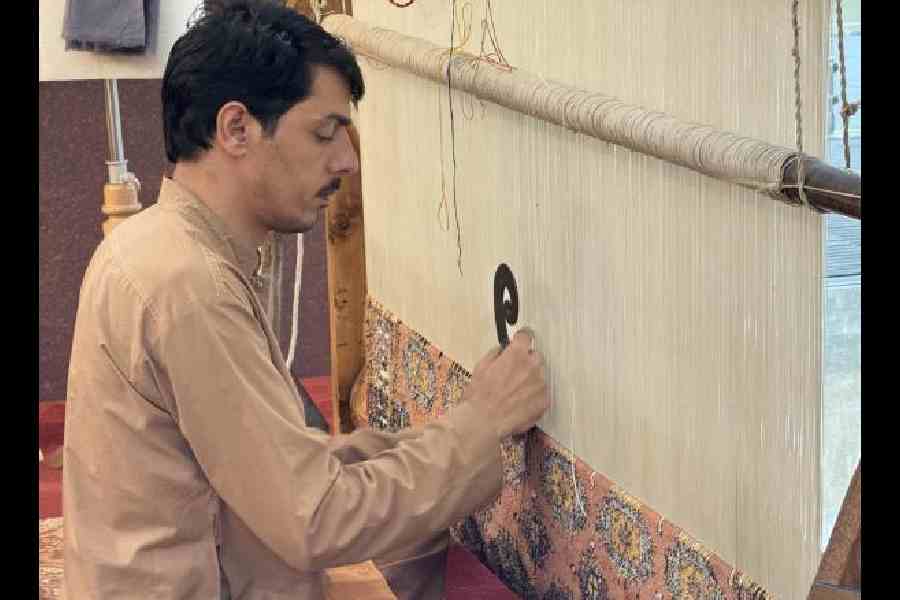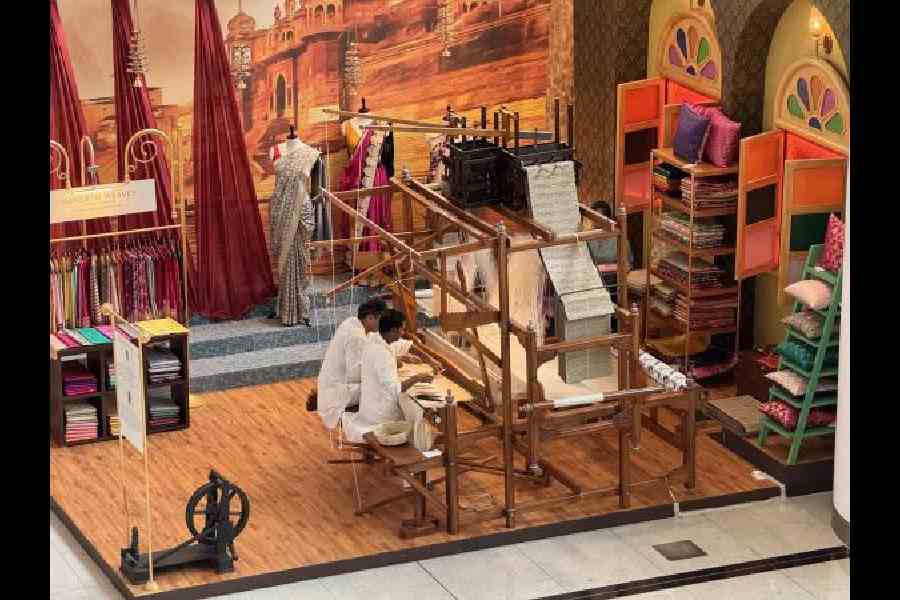A few days ago, we in Bengal celebrated Saraswati Puja, also known as Basant Panchami in other parts of India. It remains one of the most eagerly awaited festivals among the young — the studious and the not-so-studious — to this day. It is a special day when books are set aside to worship the goddess of learning and the arts, the only day in the whole year when parents don’t pester their children to study.
What’s special about the day is that young people dress in ethnic finery of Bengal — girls and young women in yellow saris, and boys and young men in yellow Panjabi/kurta and jodhpurs (the ones really keen to impress, or the older generation, even dare to drape dhotis). Swarms of youngsters venture out to public parks and shopping malls and cinemas with their friends, after offering anjali and savouring bhog, a wonderful blend of tradition and modernity that is there for all to see.
There are many festivals and occasions across India where this intimate embrace of tradition and modernity can be seen, where ethnic wear and the trendy cohabit the same spaces, adorning same bodies.
India’s fashion heritage runs deep; there are many more festivals in India, each with its unique traditional attire and costumes. Whether it’s the Kanjeevaram saris during Pongal, the white and gold Kasavu sari during Onam Sadhya, the mirror and bead embellished ghagra cholis in Rajasthan during Teej, or the risha donned during Garia Puja or worn as a turban at weddings. From the ancient cotton threads dating back to 4,000 BC to the timeless elegance of saris, dhotis, kurtas, and achkans, Indian textiles have adorned generations across the world, carrying stories of centuries past beyond our ancient frontiers.
In recent years, there’s been a growing appreciation for the authenticity and skilled craftsmanship of traditional Indian textiles, reflecting a desire for connection to heritage and culture. In today’s fast-paced world, where trends come and go in the blink of an eye, traditional Indian textiles offer a sense of timelessness and longevity. The intricate handwork and attention to detail in these textiles create pieces that are not only beautiful but also durable, allowing them to be cherished for generations to come. There has also been a growing demand for sustainable fashion in India, driven by a combination of consumer awareness and government policies promoting sustainable development.

There’s been a growing appreciation for the authenticity and skilled craftsmanship of traditional Indian textiles, reflecting a desire for connection to heritage and culture
This resurgence of interest in traditional textiles dovetails with the modern trend towards sustainability in the fashion industry. Today, as the fashion industry expands with new digital advancements and technology, customers have a variety of choices at their fingertips. They’re more knowledgeable and are volatile in terms of their purchases, often researching online for the latest trends, the best quality products, and ethical brands. Moreover, they expect to get delivery of their products to their doorsteps within a few hours. However, amidst this rapid evolution, there’s a growing awareness about the environmental and social impacts of fashion. As a result, people increasingly seek products that blend India’s rich cultural heritage with modern environmental goals.
Call for sustainability in fashion
Even though India’s textiles and garments industry contributes to two per cent of India’s GDP, or seven per cent of industry output in value terms, it is a well-known fact that fashion is one of the world’s most polluting industries. Fast fashion, marked by overproduction and rapid disposal, has propelled the industry to rank as the second-largest global polluter, contributing to 10 per cent of annual greenhouse gas emissions. While it appears that fast fashion and sustainable fashion are incompatible, creating a connection between them is essential at this time.
The concept of sustainable fashion does not diminish or condemn fast fashion; rather, it improves the techniques of fast fashion to be more environmentally conscious and ethical. It is difficult to eliminate fast fashion globally. Although the fast fashion industry is considered one of the top polluting industries, the simultaneous existence of sustainable fashion and fast fashion has the potential to create significant positive change. By transitioning to recycled materials and natural fibres, the industry can help decrease its carbon footprint in the years to come.
India’s rich fashion traditions as a solution
Being the second-largest producer of textiles in the world and the third-largest exporter of clothing, India has also seen a rise in the sustainable fashion market. Sustainable fashion brands are adopting a transformative approach by integrating traditional crafts into their designs. Whether it’s the intricate Banarasi silk or the vibrant Kanchipuram saris, these fabrics aren’t just cloth; they’re history, tales, and incredible art. By integrating these time-honoured traditions into modern fashion, brands like No Nasties, Buna, Doodlage, and Nicobar pay homage to the past while supporting artisans and weavers, ensuring their invaluable skills live on. This conscious decision not only aids local artisans and weavers but also provides consumers with an opportunity to connect with their heritage through their attire.
Amidst the rapid pace of global modernisation, India shines as a prime example of the art of weaving tradition into its fashion landscape. This evolution is more than a passing trend; it’s about combining classic techniques with new ideas to protect our heritage and lessen the fashion industry’s impact on the environment. Handloom textiles, intricate embroidery, and traditional craftsmanship not only express cultural identity but also hold the key to a sustainable fashion future. Given that the fashion sector is the world’s second-largest polluter, the fusion of India’s heritage with new-age conscious practices emerges as a promising spark.
Empowering communities through sustainable fashion
Sustainable fashion goes beyond just protecting the environment; it also empowers communities. By supporting eco-friendly initiatives, we uplift local artisans, particularly in rural areas where traditional crafts flourish. This sparks economic growth, revitalising communities while safeguarding their cultural legacy.
India’s leadership role in the G20 further underscores its commitment to sustainable practices on a global scale. With G20’s culture track championing sustainable lifestyles, climate change and circular economy, India is perfectly poised to advocate sustainable fashion. The recent G20 summit in 2023, addressing recovery, climate change, and the fashion industry’s role in similar recovery efforts, provided an unparalleled stage for world leaders to engage in the art of fashion diplomacy. The UK’s first lady Akshata Murty’s G20 stylebook made bold statements for sustainable Indian fashion, drawing attention to the significance of clothing as a tool for diplomacy and advocacy.
India’s handloom community further exemplifies the power of sustainable fashion efforts. Through collaborations and government support, like the National Action Plan on Sustainable Textiles and the Sustainable Fashion Council, artisans have seen significant economic gains. Embracing innovative, sustainable materials not only meets the demand for eco-friendly clothing but also boosts artisans’ incomes, enhancing their livelihoods. Consumer advocacy for ethical fashion has led to the emergence of sustainable brands, ensuring the continuation of traditional skills.
Partnerships with organisations like the one we had with Banglanatak for the Ripples Festival in 2022, aimed to alleviate the economic impact of Covid-19 on Bengal’s craft sector. For example, the kantha weavers of Nanoor, have contributed to equitable livelihoods, creating a more sustainable and fair supply chain. These initiatives not only reshape the economy but also preserve traditional craftsmanship, showcasing the profound impact of sustainable fashion on communities.

India’s rich fashion history can fit with today’s needs through things like recycling and using different materials, all the while staying swish and trendy
Paving the path towards sustainable fashion
The original story of Bengal’s kantha is in itself a perfect example of reusing, recycling, repurposing and now, upcycling. And there’s much the UK can learn from and contribute to India’s burgeoning sustainable fashion initiative.
Aligning India’s fashion traditions with environmental care is more than aesthetics; it’s about remaining true to our heritage while fostering a sustainable future. The fashion industry holds the potential to substantially impact environmental and societal welfare, but collective action is essential to realising this vision. To make this vision real, everyone involved — consumers, businesses, and policymakers — needs to work together.
Sustainable fashion isn’t the same thing as slow fashion. India’s rich fashion history can still fit with today’s needs through things like recycling and using different materials, all the while staying swish and trendy. Achieving sustainability in Indian fashion requires collective effort. It involves shaping a future where fashion respects both the environment and our cultural heritage, making the world fairer for future generations.
